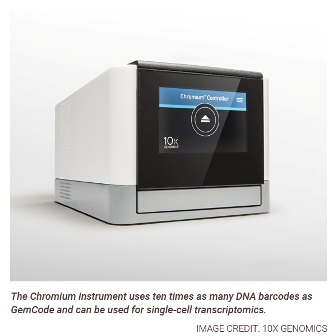10X Genomics Reveals Upgraded Platform with New Features for Single-Cell RNA Sequencing
By Aaron Krol
February 11, 2016 | 10X Genomics, a creator of microfluidics and software systems for extracting extra information from DNA samples during sequencing, has launched a new system called Chromium. Like the company’s previous platform, GemCode, Chromium segregates samples into individual microwells, where DNA in each well can be labeled with a unique barcode sequence. The process recovers information that is normally lost when scientists cut DNA into short fragments as part of sample preparation for the leading DNA sequencers.
Chromium is both more adaptable and more efficient than GemCode, and will now become 10X’s flagship product. Most notably, the new platform supports single-cell RNA sequencing, a huge area of opportunity that lets scientists observe exactly which genes are active in which cells at a given time. “Rather than just looking at an average measurement, you get very fine resolution of each of the cells in your population, and look deeply into their expression profiles,” says Ben Hindson, the President and Chief Scientific Officer of 10X. (For one application of the technique, using another technology, see “Can Big Genomic Data Reveal the Fundamental Units of the Brain?”)
But even for the DNA applications already covered by GemCode―chiefly, resolving large structural variation in the genome, and haplotype phasing to sort out DNA inherited from mother and father―10X expects Chromium to offer users better performance.
“GemCode, over time, will naturally get superseded by the Chromium instrument,” says Hindson. “We’ve developed new reagents that really improve the efficiency of our molecular barcoding of the DNA you put into the system.”
10X’s technology works by suspending cells or DNA fragments in oil as they move through the machine’s microfluidics, and depositing each in a microscopic partition, where chemical reactions attach the company’s proprietary DNA barcodes. With long DNA fragments, these barcodes can be used to tell which sequencing reads come from the same region of the same chromosome. When performing single-cell sequencing, they serve as markers for each RNA molecule’s cell of origin.
Although the basic technology is unchanged from GemCode to Chromium, the new instrument supports a roughly tenfold improvement in the number of separate barcodes that can be used on one sample, up to around one million. The Chromium instrument is also built to recognize which consumables have been loaded into it, making it easy for users to switch between DNA and RNA applications.

Through a partnership with Agilent, 10X is also introducing a new exome function, with a reagent kit that targets protein-coding regions of the genome for processing in the Chromium system. The platform’s ability to phase haplotypes and identify large structural variants could be useful in many exome sequencing studies, including investigations into families with rare genetic diseases.
10X is already taking orders for the Chromium instrument, which costs $125,000, and expects to begin shipping before July. As with the GemCode platform, Chromium’s price will keep it mainly in larger labs, used for either niche applications, or efforts to build very high-quality, nearly complete genomes. It is, however, likely to be very competitive with the long-read sequencers, like PacBio’s Sequel instrument, that retain similar information without barcoding DNA.
For single-cell RNA experiments, a fully loaded chip will run users a little shy of $10,000, and will be able to individually sort and label RNA from up 48,000 individual cells.
The Chromium launch is not the only major announcement from 10X this week: the company has also struck co-marketing deals with both Illumina and QIAGEN. From the start, 10X products have only been compatible with Illumina sequencers, and the company has recommended QIAGEN’s kits for isolating large, high-quality DNA fragments, so the new partnerships will not offer anything new to 10X’s customers. But they do give 10X the blessings of these much larger companies―especially significant because Illumina sells a competing product formerly known as Moleculo.
“I think there’s been increasing recognition of the value of long-range information,” says Hindson of the partnerships. “We were kind of working independently of each other. This is a way to make more customers aware of it, and get them on board sooner rather than later.”
10X and QIAGEN are also in early discussions to make Chromium compatible with QIAGEN’s GeneReader, a DNA sequencer released in November specifically for targeted clinical tests. Early assays on the GeneReader are strictly focused on cancer testing, an area where both large structural variants and single-cell RNA sequencing are highly relevant. The GeneReader would be only the second sequencing technology for which 10X products can prepare samples.
10X Genomics is a sponsor of the Advances in Genome Biology and Technology meeting this week in Orlando, Fla., where several early access users of Chromium will be presenting their experiences with the system.


